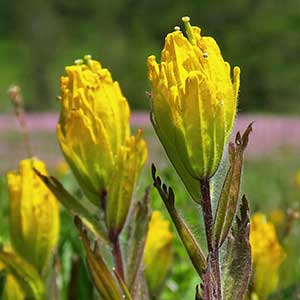Castilleja levisecta
Castilleja dissitiflora
golden Indian paintbrush, golden paintbrush
Mount Hamilton paintbrush, Mt. Hamilton Indian paintbrush
few to many, erect, ± decumbent or creeping at base, unbranched, sometimes branched, hairs spreading, medium length and long, soft, mixed with short stipitate-glandular ones.
several to many, erect to ascending, unbranched, sometimes branched, hairs spreading, long, soft, mixed with shorter stipitate-glandular ones.
green to purple or brown-tinged, linear-lanceolate proximally, oblong-ovate or -obovate distally, 0.8–5.2 cm, not fleshy, margins plane, distalmost sometimes ± wavy, involute, 3–7(–11)-lobed, apex obtuse;
lobes erect to ascending, linear to linear-spatulate, very short, toothlike, usually arising from distal 1/3 of blade, apex rounded.
green, linear to narrowly or broadly lanceolate, (1–)3–5(–6) cm, not fleshy, margins wavy (obscure on many pressed specimens), involute, usually 0–3(–5)-lobed, apex broadly acute to rounded;
lobes widely spreading, linear to narrowly lanceolate, apex acute to acuminate.
2.5–25 × 1–4 cm;
bracts bright yellow throughout, or proximally greenish, distally bright yellow, sometimes deep yellow-orange, especially with age, oblong, elliptic, or obtuse to ovate, (0–)5–9(–13)-lobed, sometimes wavy-margined;
lobes erect to ascending, oblong, short to medium length, arising above mid length, central lobe apex rounded, lateral ones rounded to acute.
2.5–10 × 2–5.5 cm;
bracts proximally greenish, distally red to red-orange, narrowly lanceolate to broadly lanceolate, 3–5-lobed;
lobes spreading, distal, if present, ascending, linear or narrowly oblanceolate to triangular, proximals long, arising below mid blade, distals short, sometimes mere teeth, near apex of central lobe, sometimes wavy-margined, apex obtuse to rounded, sometimes acute.
straight or slightly curved, 17–28 mm;
tube 12–15 mm;
beak exserted, adaxially green or greenish yellow, 6–8 mm;
abaxial lip yellow or greenish, reduced, not inflated, 2–3 mm, 25–33(–50)% as long as beak;
teeth ascending to erect, yellow, 0.5–1.5 mm.
straight to slightly curved, 24–38 mm;
tube 14–21 mm;
beak exserted from calyx, adaxially green, 11–16.5(–18) mm;
abaxial lip green, reduced, visible or not through deep front cleft in calyx, 2 mm, 13% as long as beak;
teeth incurved, green, 1 mm.
distally yellow, 13–22 mm;
abaxial and adaxial clefts 4–9.5 mm, 30–40% of calyx length, deeper than laterals, lateral 2.5–4.5 mm, ca. 25% of calyx length;
lobes linear to narrowly oblong or narrowly lanceolate, apex obtuse, sometimes rounded to acute.
whitish with green veins or green, sometimes purple, distally same color as bracts, sometimes with yellowish band below colored apices, 20–26(–29) mm;
abaxial clefts (8–)13–16(–19) mm, adaxial 7–12(–14) mm, clefts 35–50% of calyx length, deeper than laterals, lateral 2–6(–8) mm, 10–30% of calyx length;
lobes linear-lanceolate to lanceolate, apex obtuse to acute.
= 24.
= 48.
Castilleja levisecta
Castilleja dissitiflora
Castilleja levisecta is listed as threatened in the United States and endangered in Canada, where it is extremely rare. Most of its grassland habitat has been altered by development in the Puget Trough, and there are historical stations in the metro areas of what are now Victoria, Portland, and Seattle. For several decades, C. levisecta was considered extirpated from Oregon. However, recent reintroduction programs in Oregon and Washington have been very successful at reestablishing this species at several sites in the Willamette Valley. The bright yellow inflorescences often gradually age to a golden yellow color, unique in the genus.
Castilleja levisecta is in the Center for Plant Conservation’s National Collection of Endangered Plants.
(Discussion copyrighted by Flora of North America; reprinted with permission.)
Castilleja dissitiflora is endemic to several mountain ranges in central and eastern Nevada, in the upper montane and lower subalpine zones. It has the deep abaxial calyx cleft of C. linariifolia and the stipitate-glandular, wavy-margined leaves of C. applegatei var. pinetorum. Based on morphological data, Holmgren suggested that it is an allopolyploid derived from hybridization of C. applegatei var. pinetorum and C. linariifolia. His proposal is plausible and should be further tested. Castilleja dissitiflora is a tetraploid, while both putative parental species have at least some diploid populations.
(Discussion copyrighted by Flora of North America; reprinted with permission.)


